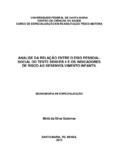| dc.contributor.advisor | Peruzzolo, Dani Laura | |
| dc.creator | Guterres, Miriã da Silva | |
| dc.date.accessioned | 2020-01-02T13:34:34Z | |
| dc.date.available | 2020-01-02T13:34:34Z | |
| dc.date.issued | 2015-07-08 | |
| dc.date.submitted | 2015 | |
| dc.identifier.uri | http://repositorio.ufsm.br/handle/1/19253 | |
| dc.description | Monografia (especialização) - Universidade Federal de Santa Maria, Centro de Ciências da Saúde, Curso de Especialização em Reabilitação Físico-Motora, RS, 2015. | por |
| dc.description.abstract | Currently, researches have been announcing that between three and four months of age, it is possible to identify risk to the child development and/or risk of psychic disruption. This question is added to the premature babies’ survival, whose preterm birth increases the risks even more. In front of this issue, it is necessary to invest in tests that sort the baby development. The present study has two main objectives: to identify possible correlations between the results of the personal-social axis of the Denver test II with the results of the IRDIs and the association of these protocols’ results between premature and full-term babies. The research is characterized as one of a quantitative approach of Cohort’s transversal stamp. Eighty premature and full-term babies between three months to three months and 29 day of age were evaluated through the personal-social axis of the Denver test II and the IRDIs. In the findings, it is verified a positive association (p=0,040) between the scores present in the IRDIs with the gestational age, however, it was not observed significant correlations between the protocols. Therefore, the discussion about the importance of the protocols that sort the babies’ development and psychic risk is raising awareness. It was also identified that the prematurity has an important predictive value, inasmuch as, the greater is the baby’s gestational age, the more is the possibility of no risks in the child development. These findings indicate the importance of continuing investigating the sorting protocols’ potential in the child monitoring, as well as, of the longitudinal tests available to the health area. | eng |
| dc.language | por | por |
| dc.publisher | Universidade Federal de Santa Maria | por |
| dc.rights | Acesso Aberto | por |
| dc.rights | Attribution-NonCommercial-NoDerivatives 4.0 International | * |
| dc.rights.uri | http://creativecommons.org/licenses/by-nc-nd/4.0/ | * |
| dc.subject | Desenvolvimento infantil | por |
| dc.subject | Avaliação | por |
| dc.subject | Prematuridade | por |
| dc.subject | Relação mãe-filho | por |
| dc.subject | Child development | eng |
| dc.subject | Assess | eng |
| dc.subject | Preterm | eng |
| dc.subject | Mother-son relationship | eng |
| dc.title | Análise da relação entre o eixo pessoal-social do teste Denver II e os indicadores de risco ao desenvolvimento infantil | por |
| dc.type | Trabalho de Conclusão de Curso de Especialização | por |
| dc.degree.local | Santa Maria, RS, Brasil | por |
| dc.degree.specialization | Reabilitação Físico-Motora | por |
| dc.description.resumo | Atualmente pesquisas têm anunciado que, na idade de três a quatro meses, já é possível identificar risco ao desenvolvimento infantil e/ou risco de transtorno psíquico. Soma-se a essa questão a sobrevida de bebês prematuros, cujo nascimento precoce aumenta ainda mais os riscos. Diante dessa problemática, faz-se necessário investir em testes que triem o desenvolvimento do bebê. O presente estudo possui dois objetivos principais: identificar possíveis correlações entre os resultados do eixo Pessoal-social do teste Denver II com os resultados dos IRDIs e as associações dos resultados desses protocolos entre bebês a termo e pré-termo. A pesquisa adota uma abordagem quantitativa de cunho transversal de Coorte. Foram avaliados oitenta bebês entre a termo e pré-termo, de três a quatro meses e 29 dias, através do eixo Pessoal-social do teste Denver II e os IRDIs. Nos resultados encontrados, verificou-se associação positiva (p=0,040) entre os escores presentes nos IRDIs com a idade gestacional, sem porém, terem sido observadas correlações significativas entre os protocolos. Logo, coloca-se em pauta a discussão sobre a importância de protocolos que triem risco de desenvolvimento e risco psíquico de bebês. Identificou-se, também, que a prematuridade tem um valor preditivo importante, na medida em que, quanto maior for a idade gestacional do bebê, maior será a possibilidade de ausências de risco ao desenvolvimento infantil. Tais constatações indicam a importância de seguir investigando o potencial dos protocolos de triagem e acompanhamento infantil, bem como dos testes longitudinais disponíveis à área da saúde. | por |
| dc.publisher.country | Brasil | por |
| dc.publisher.initials | UFSM | por |
| dc.subject.cnpq | CNPQ::CIENCIAS DA SAUDE | por |
| dc.publisher.unidade | Centro de Ciências da Saúde | por |



